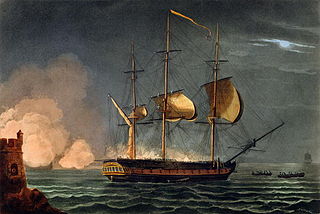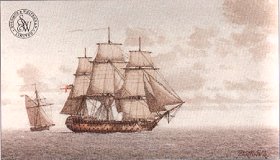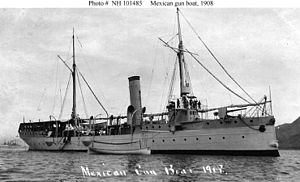
Mutiny is a revolt among a group of people to oppose, change, or remove superiors or their orders. The term is commonly used for insubordination by members of the military against an officer or superior, but it can also sometimes mean any type of rebellion against any force. Mutiny does not necessarily need to refer to a military force and can describe a political, economic, or power structure in which subordinates defy superiors.

USS New Orleans was a United States Navy protected cruiser of the New Orleans class.

USS Dolphin (PG-24) was a gunboat/dispatch vessel; the fourth ship of the United States Navy to share the name. Dolphin was the first U.S. Navy ship to fly the flag of the president of the United States during President Chester A. Arthur's administration, and the second Navy ship to serve as a presidential yacht.
The Tampico Affair began as a minor incident involving United States Navy sailors and the Mexican Federal Army loyal to Mexican dictator General Victoriano Huerta. On April 9, 1914, nine sailors had come ashore to secure supplies and were detained by Mexican forces. Commanding Admiral Henry Mayo demanded that the US sailors be released, and that Mexico issue an apology, raise and salute the US flag, and perform a 21-gun salute. Mexico refused the demand. US President Woodrow Wilson backed the demand, and the conflict escalated when the Americans occupied the port city of Veracruz for more than six months. This contributed to the fall of Huerta, who resigned in July 1914. Since the US had not had diplomatic relations with Mexico since Huerta's seizure of power in 1913, the ABC powers Argentina, Brazil, and Chile offered to mediate the conflict, in the Niagara Falls peace conference, held in Canada. The American occupation of Veracruz caused widespread anti-American sentiment.

USS Congress was a United States Navy frigate in operation between 1842 and 1862. The fourth Navy ship to carry the name Congress, she served in the Mediterranean, South Atlantic Ocean, and in the Pacific Ocean. She continued to operate as an American warship until the American Civil War, when she was sunk by the ironclad CSS Virginia in battle of Newport News, Virginia, in 1862.

The Russian battleship Potemkin was a pre-dreadnought battleship built for the Imperial Russian Navy's Black Sea Fleet. She became famous during the Revolution of 1905, when her crew mutinied against their officers. This event later formed the basis for Sergei Eisenstein's 1925 silent film Battleship Potemkin.

The Battle of Cárdenas was a minor naval engagement of the Spanish–American War fought on 11 May 1898 in the port of Cárdenas, Cuba, between an American squadron of 5 ships under Captain Chapman C. Todd and 3 small Spanish vessels under Mariano Mateu. The battle resulted in an unusually costly American reverse that dissuaded the U.S. Navy from undertaking further attacks on the port.

The third USS Preble was a Bainbridge-class destroyer in commission in the United States Navy from 1903 to 1919. She was named for Commodore Edward Preble. She saw service in World War I.

HMS Hermione was the lead ship of the Hermione class, a six-ship class of 32-gun fifth-rate frigates of the Royal Navy. She was launched on 9 September 1782 at Bristol. Hermione was commissioned and then paid off a number of times during the 1780s. She underwent repairs between October 1790 and June 1792, followed by a period spent refitting at Chatham Dockyard until January 1793. She was recommissioned in December 1792 before sailing to the Jamaica in March 1793. Hermione served in the West Indies during the early years of the French Revolutionary Wars, participating in the British attack on Port-au-Prince, where she led a small squadron that accompanied troop transports.

HMS Edgar was a 74-gun third-rate ship of the line of the Royal Navy, that saw service in the American Revolutionary, French Revolutionary and Napoleonic Wars. Launched in 1779, she fought in the battles of Cape St Vincent and Copenhagen, two of the major naval engagements of the wars.
Nuestra Belleza México 2006, the 13th Nuestra Belleza México beauty pageant, was held at the Espacio Cultural Metropolitano of Tampico, Tamaulipas, Mexico on September 2, 2006. Thirty contestants of the Mexican Republic competed for the national title, which was won by Rosa Maria Ojeda from Sinaloa, who later competed in Miss Universe 2007 in Mexico where she was a Semifinalist in the Top 10. Ojeda was crowned by outgoing Nuestra Belleza México titleholder Priscila Perales. She was the second Sinaloan to win this title.

The Second Battle of Topolobampo was a bloodless naval engagement during the Mexican Revolution. In March 1914, a rebel Constitutionalist gunboat attempted to break the blockade of Topolobampo, Sinaloa in Mexico. The attack forced federal gunboats to a further distance but failed to lift the blockade.

The Third Battle of Topolobampo was a single ship action during the Mexican Revolution. At the end of March 1914, a Constitutionalist gunboat attempted to break the blockade of Topolobampo, Sinaloa after failing in the First and Second Battles of Topolobampo. The Constitutionalist warship, Tampico, was sunk in a battle lasting a few hours by a Huertista gunboat.
HMS Alcmene was a 32-gun Alcmene-class fifth rate of the Royal Navy. This frigate served during the French Revolutionary and Napoleonic Wars under the command of several notable officers. Alcmene was active in several theatres of the war, spending most of her time cruising in search of enemy vessels or privateers, and escorting convoys. She fought at the Battle of Copenhagen in 1801 and served in the blockade of the French coasts during the later Napoleonic Wars until she was wrecked on the French coast in 1809.

The Fourth Battle of Topolobampo was a single ship action fought during the Mexican Revolution and the last naval battle of the Topolobampo Campaign. In June 1914, a Huertista gunboat sank a Constitutionalist gunboat off Topolobampo, Sinaloa in the Gulf of California.

The Battle of Antón Lizardo was a naval engagement of Mexico's Reform War, a civil war between liberals and conservative governments. It took place off the Gulf Coast town of Antón Lizardo, Veracruz, in 1860. A Mexican Navy officer, Rear Admiral Tomás Marín Sabalza, mutinied and escaped to Havana, Cuba. There he formed a squadron of armed vessels to attack merchant ships and blockade Veracruz. The liberal government of Benito Juárez declared Tomás Marín a pirate and permitted foreign navies to attack his ships. Juárez's government was supported by the United States and its navy already had several vessels patrolling in the Gulf of Mexico.

The Battle of Boca Teacapan was the result of a United States Navy expedition to destroy a Mexican pirate ship which was attacking targets in the Pacific Ocean. United States sailors and marines in several small boats pursued the pirates to the Boca Teacapan, in Sinaloa, and up the Teacapan Estuary for 42 mi (68 km) over several days in 1870 before defeating them at their hideout. The battle ended with the destruction of the pirate ship.

The action of 13 June 1898 was a minor naval engagement of the Spanish–American War fought near Cienfuegos, Cuba, between the American auxiliary cruiser USS Yankee under Commander Willard Herbert Brownson and the Spanish gunboat Diego Velázquez under Teniente de Navío de 1ª clase Juan de Carranza, which had exited the port to inspect a suspicious steamer which proved to be Yankee. Diego Velázquez, markedly inferior to Yankee in armament, managed to return to Cienfuegos, where it was joined by the small gunboats Lince and Cometa. After the appearance of the latters, Yankee decided to withdraw.

The Rio de Janeiro Affair refers to a series of incidents during the Brazilian Naval Revolt in January 1894. Following three attacks on American merchant ships in the harbour of Rio de Janeiro, a bloodless naval engagement occurred between a United States Navy warship and an ironclad of Rear Admiral Saldanha da Gama's rebel fleet. Ultimately the Americans completed their objective, and Gama offered to surrender his fleet to the Americans, but the offer was never pursued.

HMSCicala was a Royal Navy Insect-class gunboat. She was built in 1915 for shallow water work, possibly on the Danube or in the Baltic Sea during the First World War. Cicala was deployed to the Baltic for the 1918–19 British campaign against the Russian Bolsheviks. Whilst there her crew mutinied and refused to follow orders to attack a Russian shore battery. The mutiny was quelled when Admiral John Green threatened to open fire on the Cicala; five men were sentenced to imprisonment by court-martial over the matter. Cicala afterwards served on the China station, acting against pirates. She was at Hong Kong when the Japanese invaded in 1941 and provided fire support for the unsuccessful British defence. On 21 December 1941 she was struck by Japanese bombs and was afterwards scuttled.
















